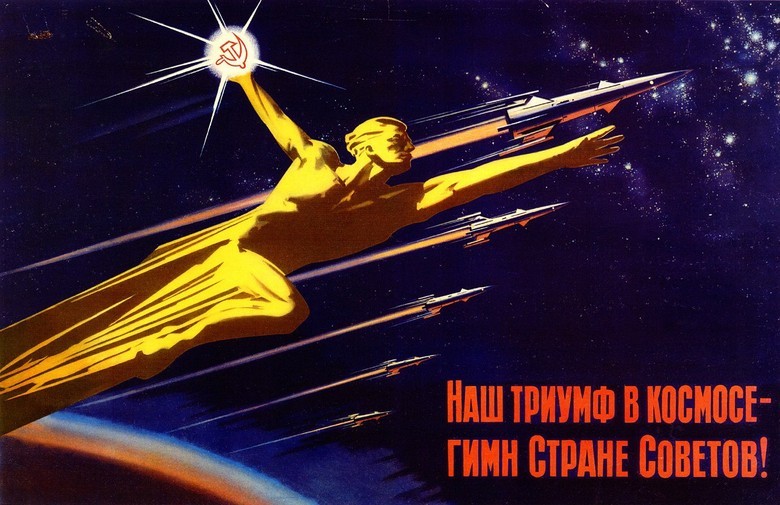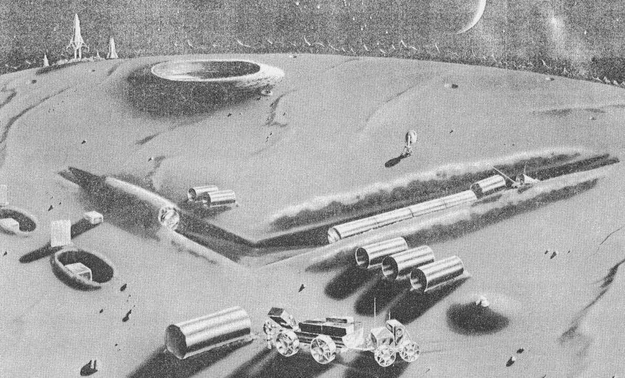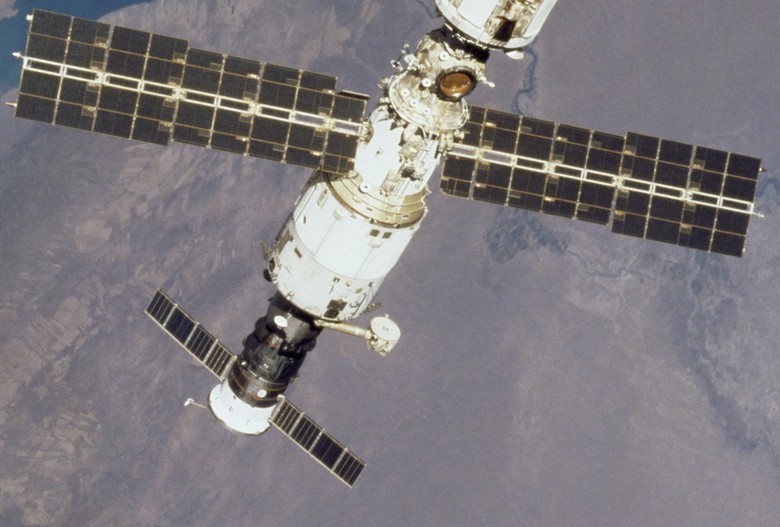Failed space projects: super heavyweight, an eye in heaven and a space hostel

There are many interesting projects in the history of technological progress. They were told a great future, they were developed - but then closed. Moreover, they closed at various stages. We decided to recall the interesting space projects that are now gathering dust in the archives of unrealized or not brought to mind ideas.
Super heavyweight
Perhaps it’s worth starting with the project of the H1 super-heavy launch vehicle , which was developed from the beginning of the 1960s. With a length of 105 meters, with a launch mass of 2735 tons, H1 could launch up to 90 tons of payload into space (up to 100 tons in the forced version).

Comparison of H1 (right) with the American super-heavy rocket Saturn-V
Rocket should have:
- orbiting the modules of a heavy space station,
- deliver to the space shipyard the components of a manned spacecraft for expeditions to Venus and Mars,
- launch a manned ship to the moon.
That is, it was expected that H1 will become one of the key components of several epoch-making space programs at once. Alas, each of the four test launches ended in failure, and then the USSR refused to participate in the lunar race, the project was closed. Because of this, like domino tiles, projects that depended on H1 also fell. For example, two Mars rovers for sampling soil have not been launched on Mars. The rejection of H1 influenced the program for creating the third Mars rover “ Mars-79 ”. The project of a heavy interplanetary spacecraft , which was supposed to deliver Soviet astronauts to Mars in the 1970s, stalled.

Urbanization of the Moon
Speaking of the moon race. The plans of Soviet designers went much further than a flight to the moon with the landing of astronauts. There were at least two projects to create lunar bases - “Star” and “Volcano”. The first project began to be developed in the 1960s. The structure of the base, in addition to the stationary building with living quarters for 12 people, included a lunar rover tractor with an inhabited trailer for long-distance expeditions. It was assumed that the Zvezda will solve scientific problems, set up experiments, and the astronauts will engage in detailed mapping of our natural satellite. Moreover, it was planned to establish regular flights to the moon with a change of astronauts' shifts.

Alas, this project was also buried under the wreckage of H1: no other launch vehicle was suitable for manned flights to the moon and the construction of the base.
But this was not the last project to conquer the Moon: in the mid-1970s, the Volcano began to be developed . An umbrella brand, as marketers would say today: under the project, a heavy launch vehicle, cargo and expeditionary ships, a moon rover, a residential complex, a laboratory-production module and a radioisotope energy generator were created. After the final deployment (after three Vulcan launches), they were going to produce oxygen at the base. However, the country was not ready to implement such a large-scale project, probably for the same political and economic reasons. The Commission of the Academy of Sciences considered that the implementation of the "Volcano" should be postponed to the 21st century ...
By the way, the USA also planned to create lunar bases. True, the projects were openly militaristic in nature. For example, Horizonwas supposed to be a full-fledged launch complex for nuclear missiles aimed at the USSR.

Moreover, it was supposed to equip the base with missiles and special anti-personnel mines to protect against ... Soviet lunar landing.

Also, the U.S. Air Force, as part of the Lunex project, proposed building an underground base for 21 astronauts. Given who was the initiator, it is unlikely that these astronauts would be engaged only in scientific research.
Eye in the sky
Of course, the Soviet Union also developed many military space projects. For example, the Almaz reconnaissance orbital station program initially envisioned the creation of both automatic and manned vehicles equipped with missiles to protect against American satellites and shuttles. But in 1978 they abandoned the manned version. The American counterpart was the Manned Orbiting Laboratory .

Fortunately, the world restrained from an arms race in space. Although we and the Americans continued (and continue to) develop military-space projects, the scope is not at all what it could be. And space is still a peaceful territory.

Space dormitory
The next project can be considered canceled, but not completely. Today, even children know what the ISS is, but many have already forgotten that the first multimodular orbital station was Mir , flooded in 2001 in the Pacific Ocean. Soon after its commissioning in the USSR, they began to develop a modernization project - Mir-2. It was planned that with the gradual replacement of modules, the station will grow significantly. And a key role in this will be played by the Energia launch vehicle , which once launched the Buran into orbit. Alas, the collapse of the USSR and the collapse of the economy put an end to both Energia itself and Mir-2: by the time Mir was withdrawn from orbit, it was outdated, and keeping this technology museum in working order was too expensive.
However, the backlog for Mira-2 was not lost: the base module, which was to become the core of the updated station, under the name Zvezda , was adapted ... on the ISS. He serves there now.

The Progress ship (black) is docked to the Star.
It's funny that the fate of the American orbital station Freedom was similar . An international project under the auspices of the United States was to be the answer to the Mir station. But for financial reasons, they refused to build, and the best practices formed the basis of the ISS American segment.

The last version of the Freedom station, never built
With a tour of the solar system
As you remember, recently the European Space Agency successfully implemented a unique project: an approach to comet Churyumov - Gerasimenko with the landing of the Fila lander . But back in the first half of the 1980s, there was a joint Soviet-French project Vesta . It was planned that two spacecraft would fly past Venus, drop probes onto it, then go around Mars, and then go off to fly around four large asteroids and, if lucky, two more comets. Such a multi-way voyage with photographing, measuring emission spectra and sampling dust and gas in those years was a very difficult scientific and technical task. Alas, politics with the economy intervened, and the project was canceled at an early stage. But after such an expedition, the flight of Rosetta to the comet would have looked like a simple imitation.
In the mid-1960s, a curious project of a manned flyby of Venus was considered in the United States . Part of the equipment was not just developed, but even manufactured. It was planned that the astronauts would collect detailed scientific data on the Venusian atmosphere, on the distribution of hydrogen in interplanetary space, on the solar spectrum - and even on Mercury, which was approaching Venus during the planned period for the flight. However, the project was closed, probably for financial reasons.
Under the hood of a spaceship
One of the main problems of interplanetary manned flights (not between the Earth and the Moon) is the propulsion system. The main disadvantage of chemical engines is the need to carry a huge amount of fuel. As one of the solutions was considered (and is being considered) a nuclear rocket engine . In the USSR, they worked on it for about 30 years , until the mid-1970s. Around the same years, the development of the American NERVA project also stopped .

In both cases, the reason is commonplace: superpowers were not ready to fork out for long-term and very expensive projects of sending a man to Mars and other planets. Countries preferred competition on the fronts of the Cold War.
* * *
This is just a small selection of space projects that could change the history of space exploration and become its bright page. There were many, unfulfilled plans and achievements of science and technology. Probably, not soon humanity will undertake to develop astronautics as actively as in the 1960-1980s. But who knows what breakthrough technologies and projects are being forged now in laboratories and research institutes.
